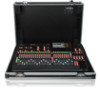Behringer X32-TP User Manual - Page 51
Setup Screen, Setup Screen: Global Tab
 |
View all Behringer X32-TP manuals
Add to My Manuals
Save this manual to your list of manuals |
Page 51 highlights
51 X32 DIGITAL MIXER Preliminary User Manual 7.5 Setup Screen The setup screen offers various controls for global, high-level functions of the console such as display adjustments, sample rates and synchronization, user settings, and network configuration. The setup screen contains the following separate tabs: 1. Global: This screen offers adjustments for various global preferences of how the console operates. 2. Config: This screen offers adjustments for sample rates and synchronization, as well as configuring high-level settings for signal path buses. 3. Remote: This screen offers different controls for setting up the console as a control surface for various DAW recording software on a connected computer. 4. Network: This screen offers different controls for attaching the console to a standard Ethernet network. 5. DCA Groups: This screen offers controls for various aspects of the console's DCA groups. 6. Card: This screen selects between the USB and FireWire connectors, and also selects the input/output configuration. None of the setup screen's tabs contain a secondary level of encoder functions, so the Layer up/down keys do not need to be used for these screens. 7.5.1 Setup Screen: Global Tab: The setup screen's global tab allows the user to adjust various global controls of the console, such as display brightness and contrast, the panning mode used by channels, text languages, and more. 1. To make adjustments in the global screen, perform the following steps: 2. Adjust the first encoder to select various console settings for pop-up messages and assorted preferences. 3. Tap the 1st encoder to turn the currently selected setting on/off. 4. Adjust the 2nd encoder to select settings for linking multiple console channels. 5. Tap the 2nd encoder to turn the currently selected setting on/off. 6. Adjust the 3rd encoder to set the console's panning mode, which affects how channel panning is performed in the stereo field. The two choices are: • LR + Mono: This is the default mode of the console. In this mode, channels can be panned between the left and right mix outputs, as well as assigned to the separate mono mix bus. In this mode, the Center/ Mono bus is not affected by from the pan control. • LCR enable: In this mode, the signal is panned from Left over Center to Right. This behavior is emulated by the faders on the Main tab, a behavior that is more intuitive than on other consoles. Note that in this mode, the definition of "mono" changes since the setup is no longer mono, but rather a setup consisting of Left-Center-Right. 7. Adjust the 4th encoder to set the brightness of the various LED lights of the console, from a range of 1-100. 8. Adjust the 5thth encoder to set the brightness of the color screen (main display), from a range of 1-100. 9. Adjust the 6th encoder to set the brightness of the individual LCD screens (channel display) above each input and output channel, from a range of 1-100. 7.5.2 Setup Screen: Config Tab: The setup screen's config tab allows adjustment of various audio-related settings, such as the console's base sample rate and use of an internal or external digital clock. It also offers choices for high-level global settings for how signal path buses operate. To adjust the various settings of the config tab, perform the following steps: 1. Adjust the 1st encoder to select between Console, Show Data, and Libraries for initialization. 2. Tap the 1st encoder to initialize the console back to its factory state. • An "are you sure" message will appear. Use the left Page Select key to cancel out of the operation, or the right key to confirm the operation and initialize the console. 3. The console's current firmware is displayed in the first column of the main color screen. • If/when a firmware update is available for the console, the user simply needs to download the new firmware file to the root level of a USB thumb drive, attach the thumb drive to the console, and then reboot. The console will see the firmware file and an update will be done automatically while booting. 4. Adjust the 2nd encoder to select the digital sample rate of the console. Choices include: • 48 kHz • 44.1 kHz 5. Tap the second encoder to assign the currently selected sample rate. Tip: Note that the sample rate of the console will be the same sample rate for any audio recorded to the onboard stereo USB recorder, as well as the sample rate output by the AES/EBU connector that may get patched into an outboard recorder. Thus, it is often beneficial to select a sample rate that is appropriate for the medium that recorded audio will eventually be used on. If the program material being recorded is audio only, with no video component, then it usually makes sense to set a sample rate of 44.1 kHz. This will ensure that any audio recorded is compatible with the 44.1 kHz sample rate of commercial audio CDs. If the program material being recorded is audio that is meant to accompany video, then it usually makes sense to set a sample rate of 48 kHz. This will ensure that any audio recorded is compatible with the 48 kHz sample rate of the various audio formats used on a video DVD. 6. Adjust the 3rd encoder to set the word clock synchronization of the console to use its internal digital clock, or slave to an external digital clock. Choices for the clock signal include: • Internal clock • External clock from the AES50-A port • External clock from the AES50-B port • XUF card















